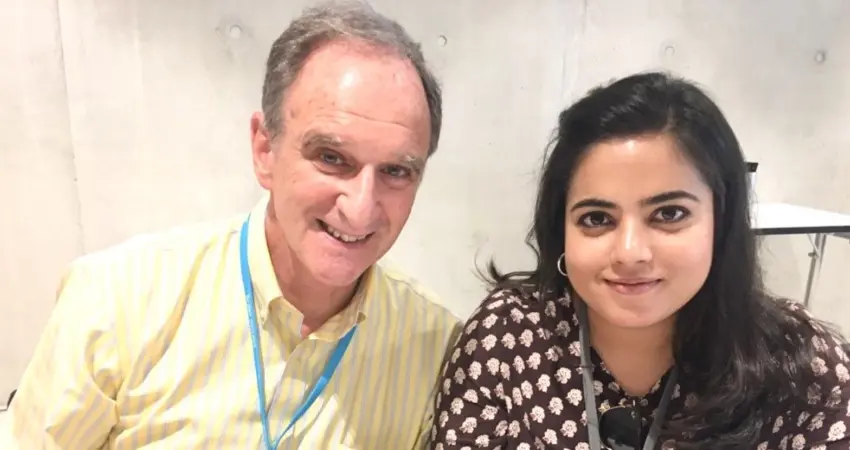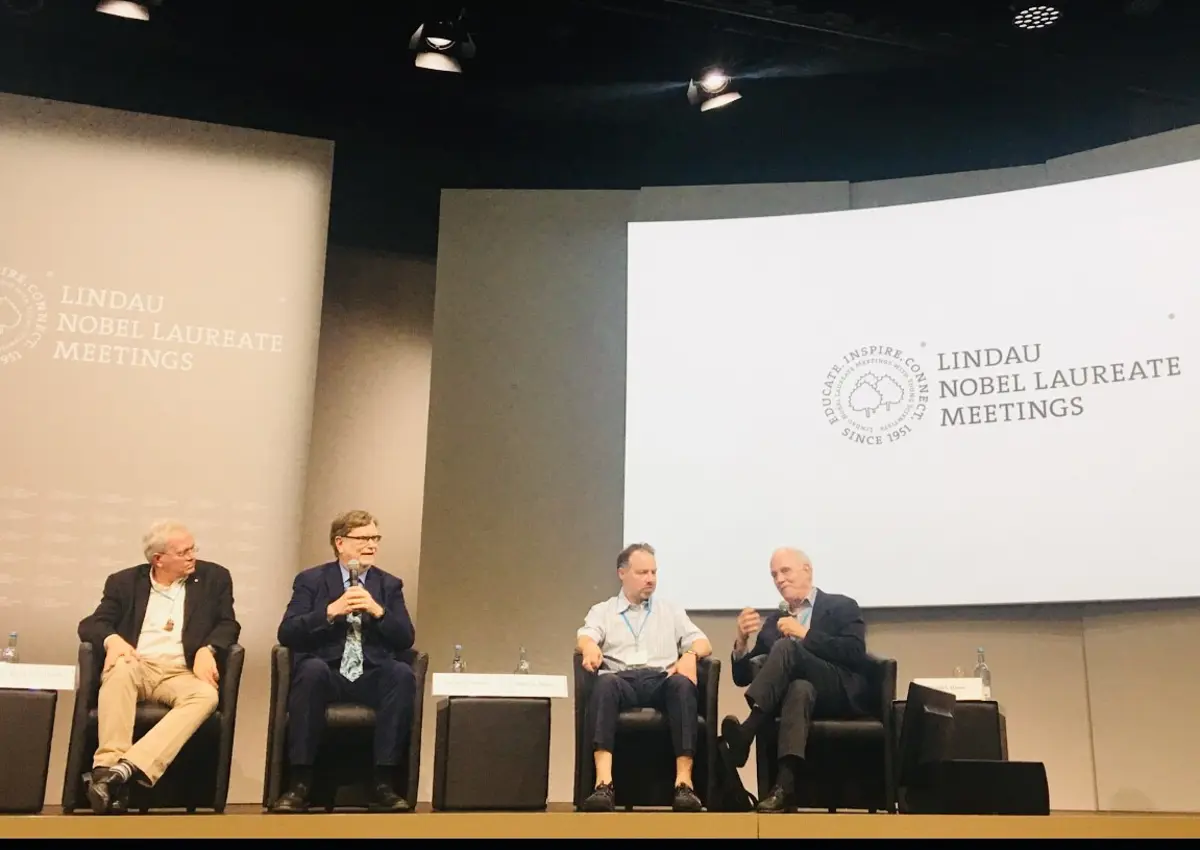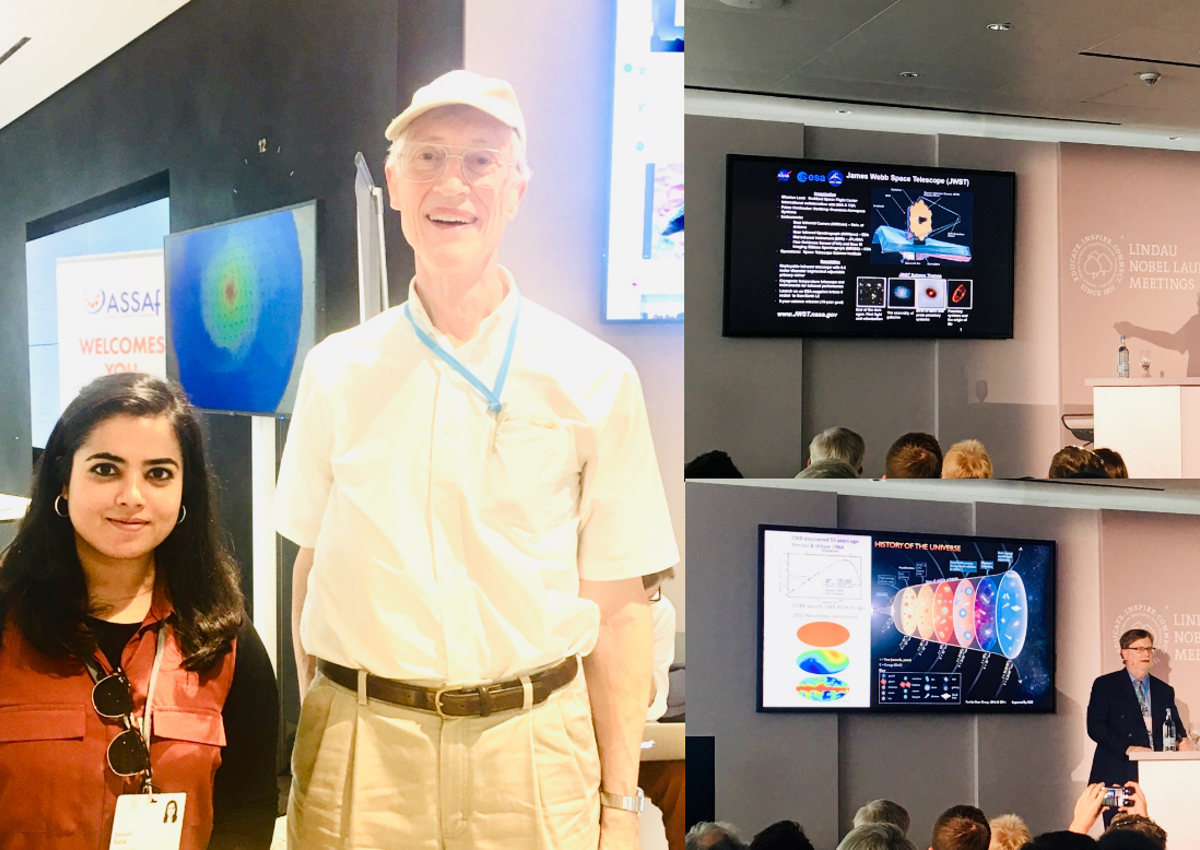06 May 2020
DPhil student meets 39 Physics Nobel Laureates
Engineering Science DPhil student Hannah Rana reflects on attending the prestigious Lindau Nobel Laureate Meeting in July 2019

Hannah Rana with Dr Martin Hellman, winner of the Turing Award in 2015 and famous for his work on cryptography.
The Lindau Nobel Laureate meeting is a programme of lectures, discussions and master classes designed to spark the exchange of ideas between scientists of different generations, cultures and disciplines. The next generation of science leaders, from graduate to post-doctoral level, is selected each year to attend the week-long meetings in Lindau, Germany. The topic of the meeting focuses alternately around the three natural sciences; physiology and medicine, physics, and chemistry.
Hannah Rana, Engineering Science DPhil candidate in the Cryogenics research group and Amelia Earhart Fellow, was selected to attend the Lindau Nobel Laureate meeting last year. Hannah’s current research entails studying and testing Stirling pulse tube cryocoolers for use in spacecraft instrumentation. She says, “Anybody with the opportunity to attend one of these [Lindau Nobel Laureate meetings] absolutely must apply! This was an incredibly life-changing experience for me as a researcher, and I’ve been recommending it to anyone I come across ever since.”
The 2019 meeting was dedicated to physics, with 39 Physics Nobel Laureates in attendance, including Professors David Gross (2004), George Smoot (2006), Brian Schmidt (2011) and Adam Riess (2011), and Dr. John Mather (2006). Their prize-winning research tackles ground-breaking discoveries, from detailed measurements of the radiation from the Big Bang, to the breakthrough that the Universe is expanding faster every second. On speaking to the Physics Laureates, Hannah says “I was surprised at how relatable and humble the Laureates were. There was a genuine desire in each of them to teach us and communicate their ideas. They wanted to nurture a sense of responsibility in each of us to push our respective fields and develop new ideas that could benefit society. I felt in continual awe of their attitude and respect towards the pursuit of knowledge and excellence.””
The meeting facilitated a variety of opportunities for the exchange of physics and research tips. A highlight for Hannah was the three thematic discussions : ‘The Dark Side of the Universe’, ‘How Can Science Change the World for the Better?’, and ‘Student, Postdoc, and Then? – Aiming for a Career in Science’ hosted by panels of laureates. Hannah recalls ‘The Dark Side of the Universe’, “It was interesting to see subtle disagreement communicated respectfully – excitingly, there is much debate yet to be had in the international physics community about the cosmological nature of the universe!”

‘The Dark Side of the Universe’ panel discussion with (left to right) Prof. Brian Schmidt (Nobel 2011; evidence for acceleration of expanding universe), Prof. George Smoot (Nobel 2006; discovery of characteristics of cosmic microwave background radiation), Prof. Adam Riess (Nobel 2011; evidence for acceleration of expanding universe), Prof. David Gross (Nobel 2004; asymptotic freedom in particle physics).
Lunch and dinner conversations gave the young scientists the opportunity to enjoy candid personal discussions to learn more about the Laureates’ lives and pathways to success. There was also a compelling urgency expressed by many of the Laureates on the need to address climate change’ As physicists their knowledge, skills, and available networks and platforms can be used to push this to the forefront of collective efforts in the wider scientific community.
Hannah adds, “Usually we feel inspired for a short amount of time interacting with a given inspirational person before resuming with our day-to-day routine tasks. Slowly that inspiration starts to fade away and we revert to familiar and ‘safer’ thinking patterns about what is possible and what we can achieve.”
“At the Lindau Nobel Laureate meetings, I felt inspired for the longest sustained period I’ve ever experienced in my life. For one week straight, I encountered some of the most brilliant minds on the planet – in physics, but also in mathematics, computing, chemistry, biology, politics/activism – and I left the meetings reflecting deeply on what exactly it means to be ‘inspirational’.”

Hannah with 2006 Physics Nobel Laureate Dr John Mather (left), astrophysicist at NASA, outlining the objectives of NASA’s James Webb Space Telescope (top, right). He won the Nobel prize in 2006 along with Prof George Smoot (bottom, right) for their work on black body form and anisotropy of cosmic microwave background radiation through NASA’s COBE mission.
Hannah also attended a ceremony in London this January to be awarded the 2019 Amelia Earhart fellowship. The fellowship is awarded internationally to researchers in aerospace science and engineering by Zonta International and aims to promote women at the very start of their research careers who show great promise in their fields. Named after Amelia Earhart, an ambitious and courageous woman who daringly built her own aircraft in which to voyage around the world, the fellowship aims to encourage creativity amongst young researchers who demonstrate a similar keen interest in pushing the boundaries of their fields.
A full interview by the Luxemburg National Research Fund, Hannah’s Lindau meetings sponsors, covers further aspects of her participation.




